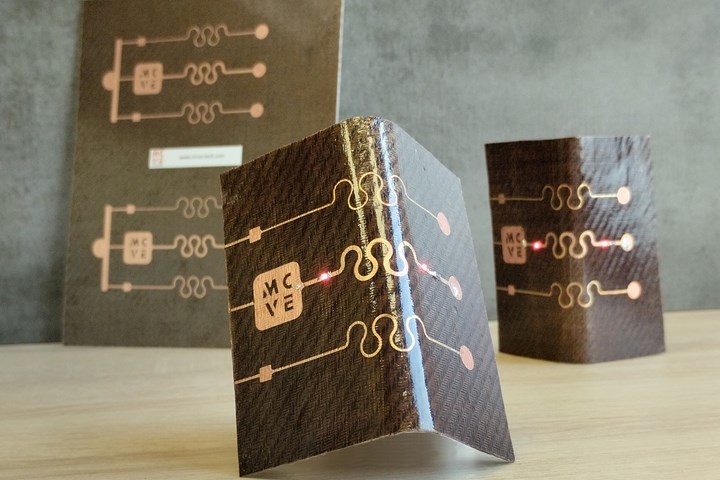MCVE 3DFlaxtronics enables functional composites for printed electronics
The novel process produces intelligent, highly functional films embedded in flax fiber organosheets with a bio-sourced PA 10-10 resin to advance electronic parts and components development.
Proof of concept made with biocomposite flax fibers, PA10-10 bio-sourced resin and thermoformed printed circuitry. Source | MCVE Technologie
MCVE Technologie (Augny, France) is launching 3DFlaxtronics, an in-mold electronics (IME) technology that can be applied to plastics and fiber-reinforced composite materials to produce functional films that provide electronic properties, enabling the production of antennas, electronic circuits, heating and more for industries like automotive, aeronautics, packaging, consumer electronics, medical and sports.
Specifically, 3DFlaxtronics is available for use in flax fiber organosheets with a bio-sourced PA 10-10 resin matrix. The process provides a large degree of freedom for integrating printed structures into bio-organosheet materials, thereby enabling the upscale of high-throughput mass production for conformable electronics.
3DFlaxtronics can be used to manufacture products like:
- Haptic controls that enable interactive responses or invisible buttons.
- Bio-conformable products that contain embedded sensors (temperature, pressure, etc.).
- Buttons for vehicle interiors.
- Creation of user interfaces for home appliances.
Notably, it is ideal for producing lighter, smaller, thinner and geometrically complex electronic components and parts. Not only does it reduce the complexity of products (i.e., fewer parts) and simplify the product assembly process, but 3DFlaxtronics is capable of increasing functionality, achieving more durable electronics (as they are embedded, protected) and enables greater freedom to design products with new shapes and functionalities. Using bio-sourced materials, 3DFlaxtronics can also meet sustainability requirements.
What is the 3DFlaxtronics process? Eoprom, an in-house copper-based formulation that promotes copper metal adhesion with an electrochemistry process, is additively deposited with electronic properties onto a 0.5-mm-thick flax organosheet reinforced with bio-sourced PA 10-10 resin. Electronic surface-mount device (SMD) components are then placed onto this functional material via pick-and-place equipment. Embedded into a top and bottom flax organosheet, the hybrid films can then be thermoformed to form 3D structures.
Related Content
-
Carbon Mobile carbon fiber powers handheld gaming platform
HyRECM technology effectively stabilizes carbon fiber’s electrical and antenna properties, enabling development of next-gen electronics, such as the Snapdragon G3x Gen 2.
-
Exel secures design patent extension for pultruded fiberglass radomes
Technique for antenna radomes forms “functional zones” inside composite material, enhancing existing 5G technology performance, application potential.
-
Plasma moves beyond improved bonding to coatings, multifunctional composites
Plasmatreat cold plasma systems clean, activate surfaces and apply nanocoatings for dielectric barriers and more.

















